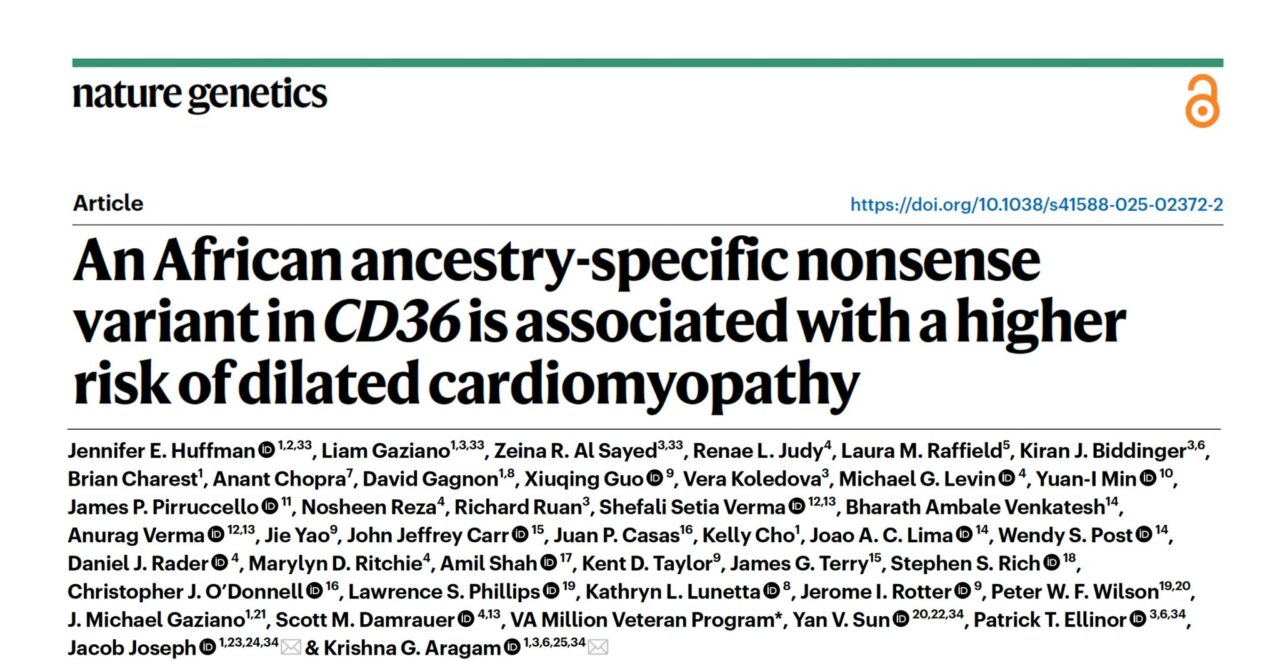
Krishna Aragam: Why are (DCM) and Heart Failure About Twice as Common in Individuals of Self-Identified Black Race?
Krishna Aragam, Director of Cardiovascular Genomics at Cleveland Clinic, posted on LinkedIn:
“Why are dilated cardiomyopathy (DCM) and heart failure about twice as common in individuals of self-identified Black race?
This risk difference has long been recognized but not fully explained by traditional risk factors or social determinants.
Our new paper in Nature Genetics identifies a key contributor: **a common loss-of-function variant in the gene CD36, specific to individuals of African ancestry, that increases risk of DCM.**
In the VA Million Veteran Program, we found that:
• 1 in 6 of African ancestry carries one copy → ~33% higher DCM risk
• 1 in 100 of African ancestry carries two copies → ~3× higher risk
• Variant is virtually absent in other populations
This single CD36 variant explains 8% of DCM in African ancestry populations — a greater impact on DCM than diabetes or chronic kidney disease — and accounts for 20% of the excess DCM risk compared with European ancestry individuals.
Mechanistically, CD36 encodes the transporter responsible for moving long-chain fatty acids (the heart’s main fuel) into cardiomyocytes. We found that loss of CD36 impairs fuel uptake, mitochondrial energy production, and contractility — revealing a myocardial energetic pathway to heart failure.
The variant’s higher frequency likely reflects positive selection in sub-Saharan Africa, where CD36 deficiency may have conferred protection against severe malaria.
This represents a new paradigm linking ancestry, metabolism, and heart failure.
Grateful to an extraordinary team across institutions, especially Jennifer Huffman, Liam Gaziano, and Zeina Al Sayed for leading this work, and Patrick Ellinor, Jacob Joseph, and Yan Sun for key support.
And most importantly, to all Veterans in the U.S. Department of Veterans Affairs Million Veteran Program, without whom this discovery would not have been possible.
Looking forward to extending this work across Cleveland Clinic, Mass General Brigham, the Broad Institute of MIT and Harvard, and other collaborating institutions to better understand the biology, refine early risk prediction, and explore how insights into myocardial energetics may guide new strategies for heart failure prevention and therapy.”
Title: An African ancestry-specific nonsense variant in CD36 is associated with a higher risk of dilated cardiomyopathy
Authors: Jennifer E. Huffman, Liam Gaziano, Zeina R. Al Sayed, Renae L. Judy, Laura M. Raffield, Kiran J. Biddinger, Brian Charest, Anant Chopra, David Gagnon, Xiuqing Guo, Vera Koledova, Michael G. Levin, Yuan-I Min, James P. Pirruccello, Nosheen Reza, Richard Ruan, Shefali Setia Verma, Bharath Ambale Venkatesh, Anurag Verma, Jie Yao, John Jeffrey Carr, Juan P. Casas, Kelly Cho, Joao A. C. Lima, Wendy S. Post, Daniel J. Rader, Marylyn D. Ritchie, Amil Shah, Kent D. Taylor, James G. Terry, Stephen S. Rich, Christopher J. O’Donnell, Lawrence S. Phillips, Kathryn L. Lunetta, Jerome I. Rotter, Peter W. F. Wilson, J. Michael Gaziano, Scott M. Damrauer, Yan V. Sun, Patrick T. Ellinor, Jacob Joseph, Krishna G. Aragam

Read full paper here.
Stay informed with Hemostasis Today.
-
Dec 19, 2025, 06:13Anna Aldehag Reflects on Her 12 Year Leadership in Sweden National Board of Health and Welfare
-
Dec 19, 2025, 05:54Abdul Mannan: APTT Mixing Studies Confuse a Lot of People
-
Dec 18, 2025, 23:14The “Normal” FVIII Level Trap in Females with Haemophilia
-
Dec 18, 2025, 23:11WFH Expands Multidisciplinary Bleeding Disorder Training in Vietnam
-
Dec 18, 2025, 17:13Daria Camilli on EuroBloodNet and EHC Collaboration for Bleeding Disorders
-
Dec 18, 2025, 16:50Marie Cambot on Innovhem’s Quantification of The HbF/HbS Ratio for SCD
-
Dec 18, 2025, 16:26Yogesh Rathod on Hematological Issues and ICU
-
Dec 18, 2025, 16:09Carlos Doti: I’m Reminded Why ASH is Such a Powerful Close to The Year
-
Dec 18, 2025, 15:23Michael Hadley: Well-Timed ACC Statement Just Out in JACC Journals
